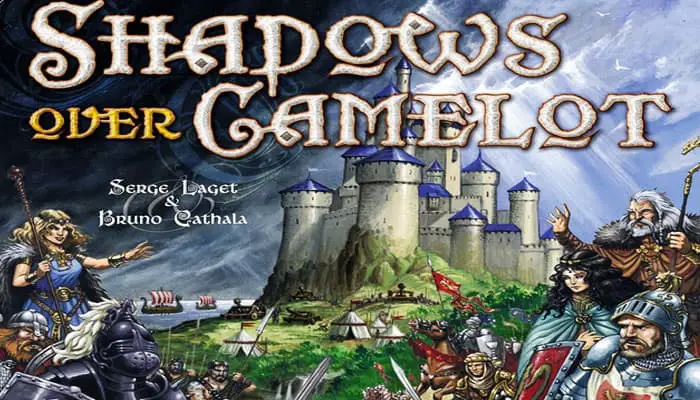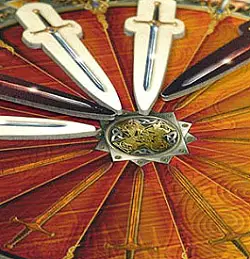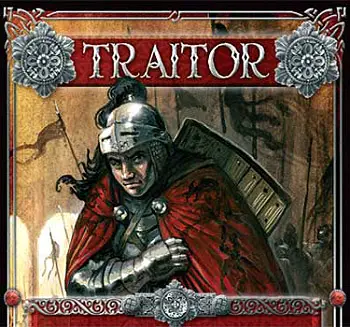

Game Components
- 1 Master gameboard of Camelot and the Round Table
- 3 additional Double-sided Quests
- 16 Swords of the Round Table
- 168 Character
- 7 Coat of Arms
- 7 standard dice and 1 special 8-sided die
- 30 Miniatures
- A Rules Booklet and the Book of Quests
Setup
Place the Master gameboard of Camelot and its surroundings in the center of the table. Punch out the Quests for Excalibur, the Holy Grail, and Lancelot & the Dragon, and lay them next to the Master gameboard. The Quest for Lancelot & the Dragon must be placed with Lancelot's side face up.
Now place the miniatures of Excalibur, the Holy Grail and Lancelot's Armor on their respective spots on these Quests. Place the 12 Siege Engines, 4 Saxons, 4 Picts and 16 double-sided Swords in a Reserve, next to the gameboard.
Randomly deal a Coat of Arms to each player. Everyone takes stock of their Knight and introduces himself and his Special Power to the group. Place your Coat of Arms face up next to you and lay a six-sided die, with the (four) face visible, on the spot reserved for it. This die will be used throughout the game to track your Knight's Life points.

Place your Knight's miniature on its designated seat at the Round Table, where it will start the game.
Separate the cards into three piles (White, Black and Loyalty). Shuffle the Black cards into a draw pile, and place them on the designated spot in Camelot.
From the White cards, give one Merlin card to each player, then shuffle the remaining White cards, including any remaining Merlin cards. Deal 5 White cards to each player and place the remaining White cards in a draw pile on the designated spot in Camelot.
Shuffle all 8 Loyalty cards, and randomly give one to each player. Secretly peek at your Loyalty card to discover your allegiance (to the Round Table if Loyal, to the forces of Evil if the Traitor), before sliding your Loyalty card face-down under your Coat of Arms. Any unused Loyalty cards are put face-down in the game's box, unseen.
Object of the Game

In Shadows over Camelot, you and your friends form a coalition of Knights who have pledged to defend the Kingdom against the forces of Evil.
Your victory hinges on the successful completion of legendary Quests, such as the search for Excalibur, the Holy Grail, or Lancelot's Armor; the tournament against the Black Knight; and numerous wars against the Saxons and Picts.
Each Quest offers its own challenges, with spoils for the victorious and terrible consequences for the defeated.
A Quest's completion often brings one or more new Swords to the Round Table. In victory, these Swords are laid White side up, in support of the Knights. In defeat, they are laid Black side up, displaying the ominous progress of Evil.
The game ends prematurely and is lost if the Loyal Knights cannot prevent the forces of Evil from doing any one of the following:
- a. surrounding Camelot with 12 Siege Engines;
- b. placing 7 or more Black Swords on the Round Table;
- c. killing all of the Loyal Knights;
Otherwise, the game ends immediately after the first Action in which a 12th Sword (or more) is laid on the Round Table. At that point, the game is won if the Loyal Knights have succeeded in placing a majority of White Swords on the Round Table.
If there is a Traitor, he wins if the forces of Evil defeat the rest of the Knights.
Game Play

As befits a monarch, King Arthur begins the game. If he is not in play, the Knight played by the youngest player starts.
Play proceeds clockwise in successive turns until: the game is lost prematurely of a 12th Sword is laid on the Round Table, at which point the color of the majority of Swords laid there determines victory or defeat.
The two Phases
The Game Turn is divided in two phases, each separated by a verification check as to whether the game ends or not.
In the first phase, The Progression of Evil phase, you must make one of three unappealing choices, all favoring the Evil forces.
In the second phase, The Heroic Actions phase, you try to help your cause by performing one (or occasionally more) of five Heroic Actions.
Game Turn Overview
On your turn, you must perform two steps:
I. Progression of Evil
You must choose one of the following three actions:
- Draw a Black card from the black draw pile and apply its effect;
- Add a Siege Engine around Camelot;
- Or Lose a Life point.
Check if the End of Game conditions have been reached before proceeding to Step 2.
II. Heroic Actions
You must now perform one of five possible Heroic Actions (you may occasionally perform more):
- Move to a new Quest;
- Perform an action related to the Quest you are on;
- Play a Special White Card;
- Heal yourself
- Or Accuse another Knight
After your Heroic Action(s), check if the End of Game conditions have been reached. If not, the game moves on to the next player.
I. Progression of Evil
At the beginning of each turn, you are faced with selecting one of three unappealing choices, all designed to help the forces of Evil in their campaign against you. Deciding which is the lesser of these evils will depend on the current game circumstances, but you must choose from one of the following: drawing a Black card; adding a Siege Engine around Camelot; or losing a Life point.
A. Drawing a Black card

If you choose to draw a Black card, pick the top card on the Black draw pile, read it aloud, and apply its effect. If necessary, refer to the Cards Manifest in Appendix 2 of the Book of Quests for more details on how to play the card.
Note that Black Knight, Lancelot and Dragon cards maybe played face down if you choose. In this case, their value should not be read aloud to the other players.
If the Black draw pile runs out as a result of your draw, reshuffle all the discarded Black cards into a fresh new Black draw pile, and simultaneously reshuffle the White discard pile and White draw pile into a fresh new White draw pile.
Throughout the game, each time a Draw pile runs out, you will have to reshuffle both piles, even if the other one has not yet been depleted.
Special Blacks
If the Black card you draw is a Special Black card:

Read it aloud and apply its effects immediately.
If you desire, you and/or some of your fellow Knights can decide to immediately cancel the card's effects by collectively playing 3 Merlin cards.
Beware: this collective use of Merlin cards to prevent a Special Black from coming into play can never be applied retroactively. e.g. if you draw Vivien or the Dark Forest and do not have 3 Merlin cards it goes into play and stays effective until the game ends, even if you later get 3 Merlin in your hands.
All cards played - including the 3 Merlin cards, if played - are then discarded onto their respective discard pile, face down.
Note: Throughout the game, discard all cards face down, regardless of their color or who played it. Cards played on the board are usually placed face up, unless indicated otherwise.
Standard Blacks
If the Black card you draw is a Standard Black card:

Play it face up on its corresponding Quest, as indicated by the Quest symbol on the card.
Unlike Special Blacks, a Standard Black card cannot be countered by the use of 3 Merlin cards when it comes into play.

The effect of a Mercenaries card is applied, at your choice, on either the Pict or Saxon War.
The Lancelot & the Dragon cards are always placed on whichever of these Quests is currently in play (Lancelot first, followed by the Dragon, once Lancelot's Quest is complete).
If the Black card you draw is a Combat card with a numerical value on it (Lancelot & the Dragon, or the Black Knight), you may choose to play it face down on the board to hide its numerical value from the rest of the group. This will likely raise a few suspicious eyebrows; but it also lets you immediately pick a free White card from the draw pile into your hand.
If the Quest for a given Black card is no longer in play (once played, the Quests for Excalibur, the Holy Grail, and Lancelot & the Dragon, are all turned over or removed), a Siege Engine is immediately added to Camelot in lieu of the card being played. The card is then discarded onto the discard pile. Do not play a card on the board itself, where the graphic is just a reminder of the card's effect.
If the Black card you draw is:
- A Black Knight, Lancelot or Dragon card that fills the last empty spot on the Evil side of at Quest;
- An Excalibur card that moves Excalibur to the last position on the Evil side of the river;
- A Despair or Desolation card that causes the entire Grail Quest to now be filled with Black cards;
- Or a Pict, Saxon or Mercenary card that puts a 4th Pict or Saxon figure on the battlefield;
The Quest you play the card on immediately ends. Check in the Book of Quests whether the Quest was won or lost, and apply the corresponding Victory or Defeat consequences, as indicated by the Quest's Victory and Defeat pictograms.
B. Adding a Siege Engine around Camelot

Take a Siege Engine from the Reserve and place it on one of the empty Siege Engine spots surrounding Camelot.
If this is the 12th Siege Engine placed around Camelot, the game is immediately lost for all but the Traitor.
C. Losing a Life point
You may always sacrifice your own stamina to keep the forces of Evil at bay. To do so, simply lose one life point and turn your Life point die so that it shows its next lowest value face up.
Your Life points can never go below zero or above six (any Life point gain above 6 is immediately forfeited).
If your Life points fall to zero (as a result of this voluntary sacrifice, or at any other point during the game, regardless of the reason for it), you die and disappear from the game at the end of your game turn. If you possessed Excalibur or Lancelot's Armor, they are now forever lost and removed from the game. All your White cards are immediately discarded face down onto the White discard pile, and your miniature removed from the board.

Your only hope: If the Holy Grail was won earlier in the game and its owner lets you drink from it, you survive your fall to zero Life points, but only once! (If you are the Grail's owner, you can use its magical power on yourself). When drinking from the Holy Grail, set your Life points back to 4 and remove the Holy Grail from the game.
Important Note: Even dead, you must not reveal your Loyalty until the end of the game. Even if you fall in battle, you will get a chance to enjoy a victory (posthumously, of course) if your side ultimately wins.
II. Heroic Actions
If you survive your Progression of Evil phase, you must then undertake one of five Heroic Actions. To help your fellow Knights, you must either:
- Move on to a new Quest;
- Perform a Quest-specific action;
- Play a Special White card;
- Heal yourself;
- Or, when permitted, make an Accusation.
Remember that in this phase, you must take one Action. So if you are on a Quest and are unable to perform the Action (s) linked to that specific Quest, you have to play a Special White card, heal yourself, or make an Accusation. If you cannot do any of the above, you must move, regardless of how much you might have wanted to stay on this Quest.
A. Moving to a new Quest
The lands surrounding Camelot are dark and foreboding. Traveling to a new destination is often a great deed in itself, and thus requires a Heroic Action.
To travel, simply grab your Knight's miniature and move it to any destination Quest of your choice. The distance between your Quest of origin and the destination, and the relative position of these Quests on the map is irrelevant. Each move always requires a single Heroic Action.
The one exception is Camelot, which has two locales (the Siege area outside the walls, and the Round Table inside) between which you can freely move without expending a Heroic Action.
A few of the Quests (the Black Knight, Lancelot) are Solo Quests. Only one Knight may be on each Solo Quest at any given time. Thus you may only move to a Solo Quest if it is presently unoccupied.
B. Performing a Quest-specific Action
Each Quest has one or more specific Heroic Actions attached to it. These Quest-specific Actions usually help advance the Quest toward a successful conclusion. You may only perform a Quest-specific Action if your Knight is currently on that Quest.
If, as the result of a Heroic Action, a Quest's End Conditions are met:
- All Knights on the Quest just ended are moved back (at no cost) to the Round Table in Camelot;
- The Quest's Victory or Defeat consequences - as indicated by the Quest's pictograms and in the Quest's entry in the Book of Quests - are applied at once;
- And all cards played on the Quest are discarded into their respective discard pile. Saxon and Pict figures, if any, are put back in reserve.
Read more about the Heroic Actions specific to each Quest
C. Playing a Special White card
Special White cards are easily identifiable by their Special White symbol.

To play a Special White card, read its text aloud and apply its effect immediately, then discard the card onto the White discard pile.
You may never play more than one Special White card per turn.
D. Healing yourself
To Heal yourself and gain one Life point, simply discard three identical cards (e.g. 3 Grail cards, or 3 Fight cards of the same value) and turn your dice over to the next value up.
You may heal yourself above your initial 4 Life points, but never above 6.
E. Making an Accusation

Accuse a fellow Knight of being a Traitor to force him to immediately reveal his Loyalty card to all of you. You do not need to be in the same location as the Knight you accuse of this treachery.
If you are the Traitor, you may choose to falsely accuse a Knight of being the Traitor for the sole purpose of sowing confusion (and turning a Black Sword over to your cause).
If the Knight you accused turns out to be Loyal, turn a White Sword (if any) over to its Black side on the Round Table. If there is no White Sword on the Round Table yet, the (wrong) accusation has no effect.
If the Knight you accuse is the Traitor, add a new White Sword to the Round Table. The Traitor is now unmasked and must follow the instructions on the back of his Coat of Arms.
Ties
All ties in the game, including:
- Fights against Siege Engines;
- Fights against the Black Knight;
- Fights in Lancelot's and the Dragon's Quests;
- And ties between White and Black swords on the Round Table at the Game's end;
are always resolved in favor of the forces of Evil and the Traitor. A stalemate is never good enough for the Knights.
End of the game

The Game ends immediately with a loss for all the Loyal Knights if there are:
- a. 12 Siege Engines surrounding Camelot;
- b. 7 or more Black Swords on the Round Table;
- c. or all the Loyal Knights (Traitor excepted) are dead;
In addition, the game stops immediately after the first Action in which a 12th Sword is laid on the Round Table.
If the Traitor is still alive and undetected at this point, he reveals his Loyalty card, and two White Swords on the Round Table are now turned over to their Black side.
Continue Reading


